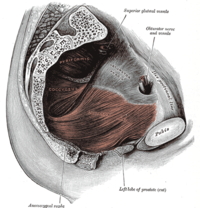
Photo from wikipedia
ABSTRACT Interstitial Cystitis/Bladder Pain Syndrome (IC/BPS) is a common and debilitating disease with poor treatment outcomes. Studies from the Multidisciplinary Approach to the study of chronic Pelvic Pain (MAPP) research… Click to show full abstract
ABSTRACT Interstitial Cystitis/Bladder Pain Syndrome (IC/BPS) is a common and debilitating disease with poor treatment outcomes. Studies from the Multidisciplinary Approach to the study of chronic Pelvic Pain (MAPP) research network established that IC/BPS patients with chronic overlapping pain conditions (COPCs) experience poorer quality of life and more severe symptoms, yet the neurobiological correlates of this subtype are largely unknown. We previously showed that ex-vivo Toll-Like Receptor 4 (TLR4) cytokine/chemokine release is associated with the presence of COPCs, as well as widespread pain and experimental pain sensitivity women with IC/BPS. Here we attempt to confirm these findings in the multisite MAPP Symptom Patterns Study using TLR4 stimulated whole blood (female IC/BPS patients with COPC n =99; without n=36). Samples were collected in tubes preloaded with TLR4 agonist, incubated for 24 hours, and resulting supernatant assayed for seven cytokines/chemokines. These were subject to a principal components analysis and the resulting components used as dependent variables in general linear models. Controlling for patient age, body mass index, and site of collection, we found that greater ex-vivo TLR4 stimulated cytokine/chemokine release was associated with the presence of COPCs (p < 0.01), extent of widespread pain (p < 0.05), but not experimental pain sensitivity (p > 0.05). However, a second component of anti-inflammatory, regulatory, and chemotactic activity was associated with reduced pain sensitivity (p < 0.01). These results confirm that the IC/BPS + COPCs subtype show higher levels of ex-vivo TLR4 cytokine/chemokine release and support a link between immune priming and nociplastic pain in IC/BPS.
Journal Title: Pain
Year Published: 2022
Link to full text (if available)
Share on Social Media: Sign Up to like & get
recommendations!